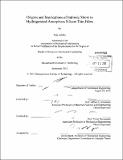| dc.contributor.advisor | Jeffrey C. Grossman and Tonio Buonassisi. | en_US |
| dc.contributor.author | Johlin, Eric (Eric Carl) | en_US |
| dc.contributor.other | Massachusetts Institute of Technology. Dept. of Mechanical Engineering. | en_US |
| dc.date.accessioned | 2013-03-28T18:24:50Z | |
| dc.date.available | 2013-03-28T18:24:50Z | |
| dc.date.copyright | 2012 | en_US |
| dc.date.issued | 2012 | en_US |
| dc.identifier.uri | http://hdl.handle.net/1721.1/78238 | |
| dc.description | Thesis (S.M.)--Massachusetts Institute of Technology, Dept. of Mechanical Engineering, 2012. | en_US |
| dc.description | Cataloged from PDF version of thesis. Page 62 blank. | en_US |
| dc.description | Includes bibliographical references (p. 57-61). | en_US |
| dc.description.abstract | Despite decades of research on hydrogenated amorphous silicon (a-Si:H), there remains much to be understood about the relationship between deposition conditions and the resulting structural, optical, and bulk properties of the material. In this work we investigate these correlations for a-Si:H films created using plasma enhanced chemical vapor deposition (PECVD), focusing on the creation of intrinsic stresses within the films. Through experimental examination of the deposition process pressure, we model the plasma ion momentum using a combination of theoretical models and empirical trends. We find that compressive stress is controlled by ion bombardment causing of peening the film, and leading to lattice distortion in the material. Conversely, tensile stress is created through bombarding ions collapsing nano-sized voids within the material, which are formed during the vapor-phase deposition. Combining our model of ion momentum with the theory of ion peening creating compressive stress, we are able to fit the process conditions to the observed the compressive regime of our films. Furthermore, by analyzing the hydrogen content in voids within our films, we are able to predict the film porosity, and thereby model the void collapse, yielding the tensile stresses. The balance between these compressive and tensile stress forces determines the final intrinsic stress state, and allows our refined model to fit the entire range of highly compressive to highly tensile film stresses. Finally, we present correlations between film structural properties and observed optical properties, real and imaginary refractive indices and optical band gap, factors important for the creation of a-Si:H based devices. | en_US |
| dc.description.statementofresponsibility | by Eric Johlin. | en_US |
| dc.format.extent | 62 p. | en_US |
| dc.language.iso | eng | en_US |
| dc.publisher | Massachusetts Institute of Technology | en_US |
| dc.rights | M.I.T. theses are protected by
copyright. They may be viewed from this source for any purpose, but
reproduction or distribution in any format is prohibited without written
permission. See provided URL for inquiries about permission. | en_US |
| dc.rights.uri | http://dspace.mit.edu/handle/1721.1/7582 | en_US |
| dc.subject | Mechanical Engineering. | en_US |
| dc.title | Origins and implications of intrinsic stress in hydrogenated amorphous silicon thin films | en_US |
| dc.type | Thesis | en_US |
| dc.description.degree | S.M. | en_US |
| dc.contributor.department | Massachusetts Institute of Technology. Department of Mechanical Engineering | |
| dc.identifier.oclc | 829815502 | en_US |
